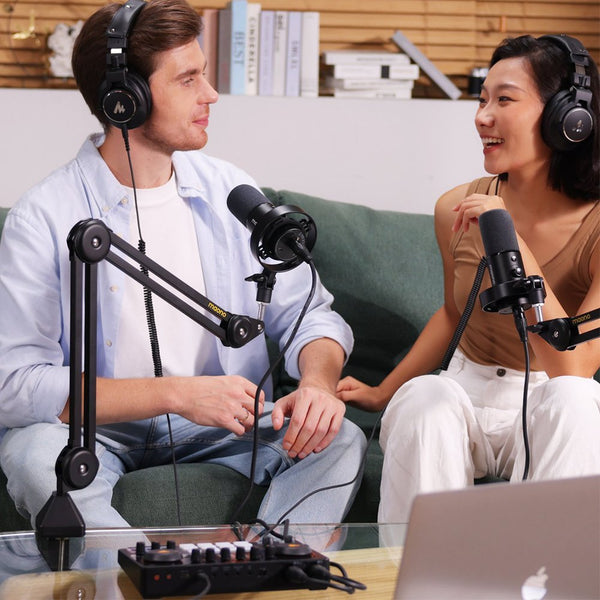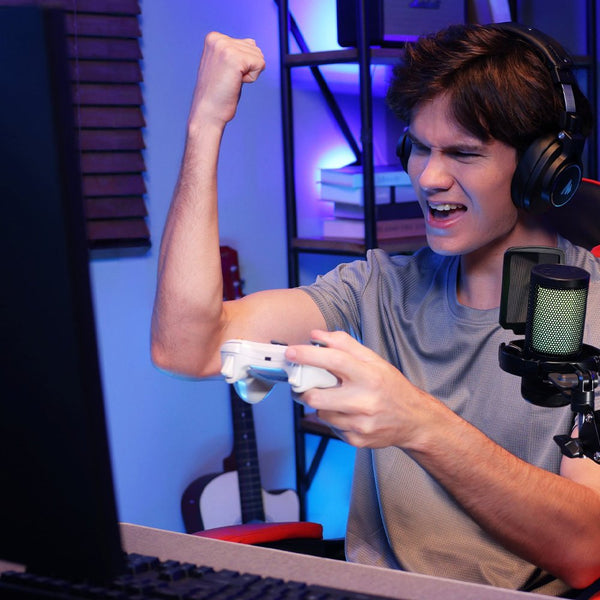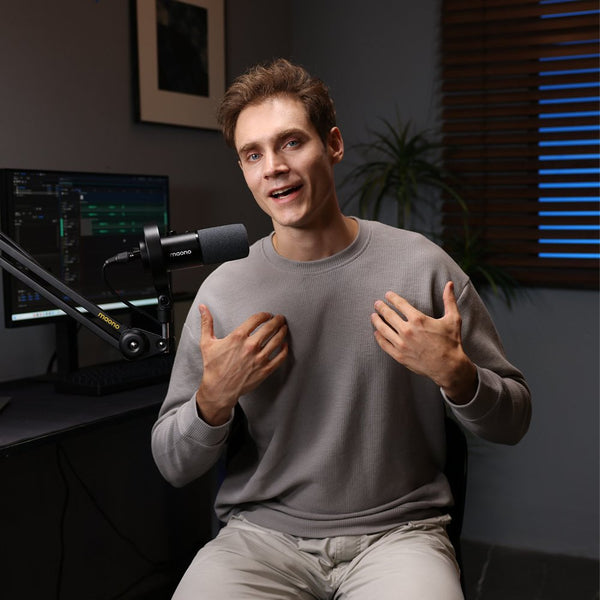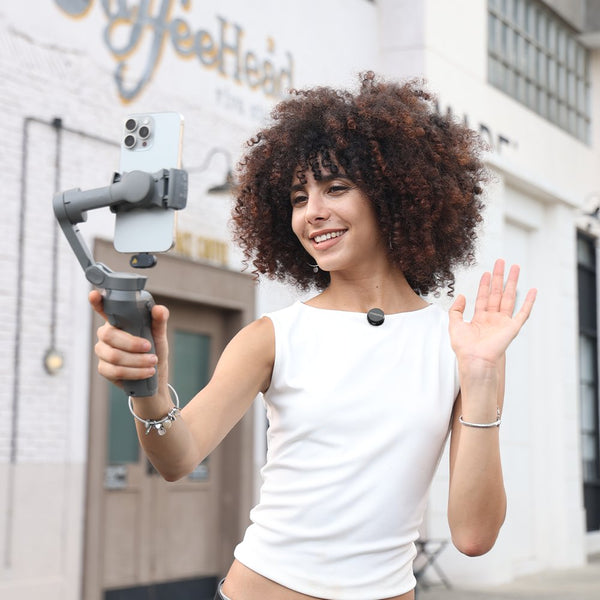The Role of Clear Audio When Sharing Calorie Deficit Strategies
In today’s digital-first world, sharing your calorie deficit journey through vlogs or social media reels has become a powerful way to inspire, educate, and connect with others on similar paths. However, while visuals are important, clear, high-quality audio is what keeps viewers listening. If your audience can’t understand your advice about portion sizes, tracking macros, or managing cravings due to poor sound, they’ll likely scroll past—even if your content is valuable.
Whether you’re meal-prepping in a busy kitchen, filming outdoor walks, or talking through your fitness routine at the gym, a wireless microphone system can elevate your content by capturing professional-grade audio on the go. In this guide, we’ll explore how to vlog your calorie deficit journey clearly and effectively using wireless and clip-on Lavalier microphones, especially for platforms like YouTube, TikTok, and Instagram Reels.

How to Vlog Your Calorie Deficit Journey Using a Wireless Mic
Documenting your calorie deficit process can build trust with your audience—but only if they can hear you clearly. Wireless microphones offer flexibility and freedom of movement, making them ideal for creators filming solo, especially during everyday tasks like walking, cooking, or exercising.
Start by choosing a wireless microphone system that pairs easily with your camera or smartphone. A Lavalier lapel microphone clipped to your shirt will keep your hands free while ensuring your voice is front and center. Whether you're explaining your daily calorie intake, offering portion control tips, or breaking down macro tracking, clear audio helps your message land more effectively.
Key tip: Record in short segments, use natural light, and keep the mic around 6–8 inches from your mouth for optimal vocal clarity.
Filming Healthy Meals & Calorie Tips Clearly with Lavalier Mics
Meal prep videos and what-I-eat-in-a-day vlogs are favorites among fitness audiences. But kitchens are noisy—blenders, sizzling pans, and background chatter can easily overpower your voice. That’s where wireless Lavalier microphones shine.
Unlike built-in smartphone or camera mics that pick up everything around you, a clip-on Mic Lavalier captures focused audio from your voice, reducing background noise. When demonstrating how to cook a low-calorie stir fry or explaining the calorie breakdown of your protein smoothie, a lav mic ensures your viewers hear every helpful tip without distractions.
Pair your mic system with a wind muff or foam cover if you're near loud appliances or open windows to reduce interference. It also helps to use voice notes or voiceovers during B-roll shots, synced later in editing software.
Creating Viral Calorie Deficit Reels: Audio Tips with Wireless Mics
Short-form video is king on platforms like Instagram Reels and TikTok. To go viral with calorie deficit content, you’ll need more than good lighting and editing—you’ll need audio that hooks the viewer within seconds.
A wireless microphone boosts your voice clarity, making your quick diet tips or myth-busting reels stand out. Instead of relying on background music or text overlays alone, narrate your calorie tips with punchy audio: “Want to lose fat without starving? Try calorie cycling!”—delivered confidently and crisply.
Use a wireless transmitter and receiver combo that allows movement while keeping your voice stable. Consider syncing your voice with trending sounds or background music while ensuring your voice remains dominant. Clear, energetic speech matched with practical advice is the formula for watch-worthy content.
Walking & Talking: How to Share Diet Tips Using a Clip-On Mic
Walk-and-talk vlogs have become increasingly popular for health and wellness creators. They feel authentic, spontaneous, and relatable. But wind, traffic, and your own footsteps can easily muffle your voice.
To maintain sound quality on the move, use a wireless clip-on microphone with noise reduction features. Clip it securely to your shirt or jacket, and use a wind muff outdoors. Some wireless microphone systems even offer internal audio recording for backup if connection issues occur.
Use your walking time to talk about topics like:
-
What you ate that day on a calorie deficit
-
How to deal with cravings
-
Smart swaps to reduce calories
-
Mindful eating strategies while traveling
This unscripted, on-the-go format feels personal—and the right audio setup ensures it also sounds polished.
FAQs:
1. What are the easiest ways to explain calorie deficit to beginners on video?
Use visuals and analogies (like comparing your body to a fuel tank), keep sentences short, and maintain eye contact with the camera. Let your wireless mic capture your natural tone and enthusiasm.
2. How do I record calorie tracking tips clearly for TikTok or YouTube Shorts?
Use a wireless Lavalier mic close to your mouth, shoot in a quiet space, and speak directly to the camera with energy and clarity. Keep tips under 30 seconds for best engagement.
3. What’s the best way to film low-calorie meal preps without background noise?
Use a wireless mic and record in segments. Turn off loud appliances while filming voice portions and use music or voiceover for noisy sections.
4. How can I share weight loss progress outdoors without muffled audio?
Use a wireless clip-on mic with a windscreen or muff, and avoid filming directly into the wind. Consider early morning or sunset hours when it's quieter outside.
5. Why does good audio matter when vlogging health and fitness advice?
Clear audio builds credibility, keeps viewers engaged longer, and ensures your advice is understood and actionable.
6. What’s the best wireless microphone for fitness and food content creators?
Look for lightweight, dual-transmitter lavalier microphone systems like Maono Wave T5, Rode Wireless GO II, or DJI Mic for excellent clarity, range, and battery life.
7. Can I use a wireless clip-on mic while cooking or walking outside?
Yes. Clip-on wireless mics are perfect for mobile, hands-free filming in kitchens, parks, or gyms—just ensure good mic placement.
8. How do wireless mics reduce noise in busy kitchens or gyms?
They focus on your voice and ignore ambient sound due to their omnidirectional or cardioid pickup patterns, especially when paired with foam covers.
9. What’s the difference between a wireless lavalier mic and a headset mic for vlogging?
Lavalier mics are discreet and better for lifestyle vlogs. Headset mics are bulkier but good for studio or gym sessions with intense movement.
10. How do I connect a wireless mic to my smartphone or DSLR for food content?
Most wireless mics include TRS or TRRS adapters. Use the proper cable for your device (or a USB-C/Lightning adapter if needed).
11. How do I mount a wireless microphone while filming solo?
Use a magnetic clip, shirt clip, or even medical tape to secure the mic near your chest or collarbone.
12. Which wireless mic is best for walking vlog updates or weight loss check-ins?
The Maono Wave T5 or T1 Mini both offer excellent range, compact design, and noise reduction for outdoor content.
13. Do I need a wind muff or pop filter for outdoor fitness content?
Yes—wind muffs are essential for outdoor shoots to reduce harsh wind sounds, especially during walking or biking shots.
14. How do I sync wireless mic audio with my calorie deficit vlog footage?
Clap before you begin talking to create a sync point. Use editing software like CapCut, Final Cut Pro, or Adobe Premiere to align the audio and video tracks.
15. Can a budget wireless mic work well for fitness YouTube videos?
Yes. Affordable options like the Maono Wave T1 Mini offer surprisingly professional results for under $100.
16. Does better audio actually improve engagement on health videos?
Yes. Viewers are more likely to watch, like, and share videos where they can clearly hear and follow the advice being shared.
17. How do I share calorie deficit tips in noisy environments without losing followers?
Use a good Lavalier mic with background suppression. Keep speech concise and film during quieter times.
18. What’s the most professional yet beginner-friendly wireless mic for daily vlogging?
The Maono Wave T5 offers studio-level quality with an easy setup and dual-transmitter recording. It;s considered as one of the best lavalier microphone options in the market today.
19. How do wireless mics help build credibility in health & fitness content?
Great sound quality reflects professionalism. When your voice is clear, your authority and trustworthiness increase.
20. What mic settings should I use when filming gym routines and diet tips?
Use low gain settings in loud environments and adjust your mic position to minimize breath pops and clothes rustling.

Conclusion
Vlogging your calorie deficit journey isn’t just about what you show—it’s about what your audience hears. With viewers scrolling faster than ever, poor audio can mean lost attention, reduced engagement, and missed opportunities to share your valuable fitness insights.
Investing in a wireless microphone system like the Maono Wave T5 or T1 Mini allows you to record anywhere—your kitchen, the gym, the park—with clarity and confidence. Whether you're cooking low-calorie meals, walking and talking about progress, or filming high-energy Reels, a Good Lavalier mic ensures your voice is heard—literally and figuratively.
So clip that Mic Lavalier on, press record, and start inspiring your audience one clear calorie-deficit tip at a time.
Related Article:
Mastering Calorie Deficit: Weight Loss Tips, Tools & Vlogging Gear



